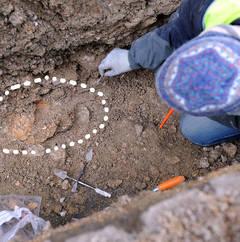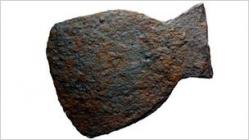02 FEVRIER
INSTITUT SUPERIEUR D'ANTHROPOLOGIE INDI-UNI :
INSCRIPTION 2012 / 2 COURS A DISTANCE
REGISTRATION 2012 / 2 ONLINE COURSES
FRANCE –  Niort - L'archéologue de la Ville, Céline Trézéguet, a effectué ce mercredi 1er février 2012 des relevés sur la toute dernière découverte archéologique en centre-ville. Après la mise à jour cette semaine par l'Inrap de fondations d'époque médiévale place du Donjon, l'attention se tourne maintenant du côté de la rue du Temple. A cet emplacement se situait au Moyen-Age un cimetière qui jouxtait l'église des Cordeliers érigée sur le site de l'actuel Temple. Sans grande surprise donc, deux calottes crâniennes, dont celle d'un enfant, ainsi que des ossements ont été trouvés à l'entrée de la rue Temple. A proximité du plus petit crâne, notre archéologue a découvert une épingle métallique qui aurait pu servir à fermer un linceul, ainsi que des morceaux de céramiques. L'ensemble est difficile à dater précisément sur place. Des recherches plus poussées seront effectuées dans un second temps à partir des relevés qui ont du prendre fin dans la journée.
Niort - L'archéologue de la Ville, Céline Trézéguet, a effectué ce mercredi 1er février 2012 des relevés sur la toute dernière découverte archéologique en centre-ville. Après la mise à jour cette semaine par l'Inrap de fondations d'époque médiévale place du Donjon, l'attention se tourne maintenant du côté de la rue du Temple. A cet emplacement se situait au Moyen-Age un cimetière qui jouxtait l'église des Cordeliers érigée sur le site de l'actuel Temple. Sans grande surprise donc, deux calottes crâniennes, dont celle d'un enfant, ainsi que des ossements ont été trouvés à l'entrée de la rue Temple. A proximité du plus petit crâne, notre archéologue a découvert une épingle métallique qui aurait pu servir à fermer un linceul, ainsi que des morceaux de céramiques. L'ensemble est difficile à dater précisément sur place. Des recherches plus poussées seront effectuées dans un second temps à partir des relevés qui ont du prendre fin dans la journée.
http://www.vivre-a-niort.com/fr/dernieres-infos/2444/
ROYAUME UNI –  Slimbridge - A Viking axe head found in a Gloucestershire village could be evidence of a battle more than 1,100 years ago, according to archaeologists. The wrought iron object, found in Slimbridge in 2008, has now been identified as being of Viking origin. Historians say a band of Vikings sailed up the River Severn and fought against the Anglo-Saxons in 894 AD. Archaeologists say where the axe head was found is where they could have tied up their ships. According to historians King Alfred the Great fought the Vikings in a bloody battle at Minchinhampton, about 10 miles from Slimbridge, in 894 AD. Three Viking princes were killed in the battle, and fighting could have ranged over a wide area of the Berkeley Vale.
Slimbridge - A Viking axe head found in a Gloucestershire village could be evidence of a battle more than 1,100 years ago, according to archaeologists. The wrought iron object, found in Slimbridge in 2008, has now been identified as being of Viking origin. Historians say a band of Vikings sailed up the River Severn and fought against the Anglo-Saxons in 894 AD. Archaeologists say where the axe head was found is where they could have tied up their ships. According to historians King Alfred the Great fought the Vikings in a bloody battle at Minchinhampton, about 10 miles from Slimbridge, in 894 AD. Three Viking princes were killed in the battle, and fighting could have ranged over a wide area of the Berkeley Vale.
http://www.bbc.co.uk/news/uk-england-gloucestershire-16829808
ROYAUME UNI –  Lynn - An archaeological survey carried out on a former grain silos site near Lynn’s South Quay should help to fill gaps in knowledge of that part of the town’s historic core, an expert says. Dr Ken Hamilton, senior historic environment officer with Norfolk County Council, said the recent dig at the former Sommerfeld and Thomas site, between South Quay and Millfleet, had uncovered medieval deposits and what appeared to be a series of 18th century surfaces, like cobbles. He said: “It’s certainly of interest because that corner is represented on historic maps but it has not been very clear what goes on at the junction of Millfleet and the Ouse. It should lead to more statements about the town’s history in that area.” Dr Hamilton said when the town was founded the river line was much further east and it gradually migrated westwards. In the 10th to 11th century, the excavation site was in the middle of the river and it was reclaimed in the 15th to 16th century. But the western half of the site was not reclaimed until the 19th century. In 1973, grain silos were constructed beside the quay and there were also brick buildings on the site, which had previously housed granaries since the 19th century and before that an oil mill. Bricks and cobbles from what appeared to be a series of 18th century surfaces were discovered less than a metre down and medieval deposits at greater depth, but no trace was found of the old quayside, he said.
Lynn - An archaeological survey carried out on a former grain silos site near Lynn’s South Quay should help to fill gaps in knowledge of that part of the town’s historic core, an expert says. Dr Ken Hamilton, senior historic environment officer with Norfolk County Council, said the recent dig at the former Sommerfeld and Thomas site, between South Quay and Millfleet, had uncovered medieval deposits and what appeared to be a series of 18th century surfaces, like cobbles. He said: “It’s certainly of interest because that corner is represented on historic maps but it has not been very clear what goes on at the junction of Millfleet and the Ouse. It should lead to more statements about the town’s history in that area.” Dr Hamilton said when the town was founded the river line was much further east and it gradually migrated westwards. In the 10th to 11th century, the excavation site was in the middle of the river and it was reclaimed in the 15th to 16th century. But the western half of the site was not reclaimed until the 19th century. In 1973, grain silos were constructed beside the quay and there were also brick buildings on the site, which had previously housed granaries since the 19th century and before that an oil mill. Bricks and cobbles from what appeared to be a series of 18th century surfaces were discovered less than a metre down and medieval deposits at greater depth, but no trace was found of the old quayside, he said.
http://www.lynnnews.co.uk/news/campaigns/incinerator/dig_unveils_medieval_remnants_1_3472712
USA – South Carolina - State regulators’ recent decision to no longer require coastal developers to conduct archaeological surveys before building is a short-sighted and unfortunate choice. South Carolina has archaeological sites that stretch back up to 12,000 years, said Elizabeth Johnson, deputy State Historic Preservation Officer. The coast in particular, as the first place Europeans settled, is rich in sites of historic significance. Many have been found, identified and studied, but nobody really knows how many others are out there to be discovered. Previous surveys have found wonderful examples of the state’s history, including a slave plantation house in Georgetown County and a slave row. The village of Childsbury in Berkeley County is another site found during one of these predevelopment checks. Dr. L.M. Drucker, an archaeologist with AF Consultants in Columbia, described Childsbury as a hub of Colonial commerce that once had a racetrack, free school, a tavern and doctors’ and lawyers’ offices. “The coast is such a primary area for historic settlement and it’s getting developed so much, it’s a shame,
http://www.myrtlebeachonline.com/2012/01/30/2629259/history-paved-over.html
FRANCE – Rennes - Depuis le 30 novembre, le couvent des Jacobins, près de la place Sainte-Anne de Rennes, est le théâtre d’un gigantesque chantier de fouille archéologique de 8 000 m². L’opération, qui va durer entre 15 et 18 mois, a déjà mis au jour de nombreux vestiges. Dans le premier secteur étudié, le jardin du cloître, les archéologues de l’Inrap ont découvert des vestiges modernes et médiévaux. Ils donnent des informations sur les étapes de construction du couvent et sur son occupation militaire dans les années 60. Les vestiges gallo-romains, nombreux, révèlent que le jardin est situé sur une ancienne voie romaine très fréquentée, bordée par une galerie de circulation piétonne, dans un quartier alors très commerçant. Des vestiges du XVIIe ont également été mis au jour : une vingtaine de sépultures, éparpillées dans le jardin. Cette zone devait servir de cimetière. De très nombreuses pièces ont aussi été minutieusement sorties du sol par les archéologues : vases, tomettes (petits pavés), clous rouillés… Une découverte plus anecdotique a aussi été extraite d’une fosse dans le jardin : des dizaines de boutons. Ces boutons étaient probablement stockés par les militaires, qui tenaient une boutique de vêtements. Ces premiers résultats vont désormais se poursuivre par une étude au niveau de l’intérieur des bâtiments. Ces fouilles, prescrites par la Direction régionale des affaires culturelles de Bretagne, sont menées en amont de la transformation du couvent en Cité des congrès.
http://www.ouest-france.fr/actu/actuLocale_-Rennes.-Fouilles-au-couvent-des-Jacobins-des-vestiges-gallo-romains-et-medievaux-decouverts_40771-2039619-pere-region--29151-abd_filDMA.Htm
USA –  - Sleeping Bear Dunes - A substantial hull piece that shipwreck experts believe comes from the schooner Jennie and Annie, which sunk in the Manitou Passage in 1872, has washed up on a remote stretch of Lake Michigan beach north of Empire in the Sleeping Bear Dunes National Lakeshore. Sleeping Bear Dunes historians believe the schooner fragment, estimated to be about 40-feet long and peppered with twisted metals spikes, is part of the ship’s bilge keelsons, which the Oxford Handbook of Maritime Archeology says were long timbers running most of the ship’s length, strengthening the keel. It’s one of several fragments of the wreck to wash ashore over the years, said Laura Quackenbush, museum technician with park service. In fact, wreck fragments from the Jennie and Annie, as well as other ships which foundered off the dunes coastline, wash ashore once or twice a year. The Jennie and Annie was one of the wrecks surveyed in 1995 when the passage was being readied as an underwater preserve, Quackenbush said. The ship, named for relatives of Port Oneida founder Thomas Kelderhouse, foundered in a mid-November storm north of Sleeping Bear Point. Six or seven people died.
- Sleeping Bear Dunes - A substantial hull piece that shipwreck experts believe comes from the schooner Jennie and Annie, which sunk in the Manitou Passage in 1872, has washed up on a remote stretch of Lake Michigan beach north of Empire in the Sleeping Bear Dunes National Lakeshore. Sleeping Bear Dunes historians believe the schooner fragment, estimated to be about 40-feet long and peppered with twisted metals spikes, is part of the ship’s bilge keelsons, which the Oxford Handbook of Maritime Archeology says were long timbers running most of the ship’s length, strengthening the keel. It’s one of several fragments of the wreck to wash ashore over the years, said Laura Quackenbush, museum technician with park service. In fact, wreck fragments from the Jennie and Annie, as well as other ships which foundered off the dunes coastline, wash ashore once or twice a year. The Jennie and Annie was one of the wrecks surveyed in 1995 when the passage was being readied as an underwater preserve, Quackenbush said. The ship, named for relatives of Port Oneida founder Thomas Kelderhouse, foundered in a mid-November storm north of Sleeping Bear Point. Six or seven people died.
http://www.mlive.com/news/index.ssf/2012/02/140-year-old_shipwreck_fragmen.html